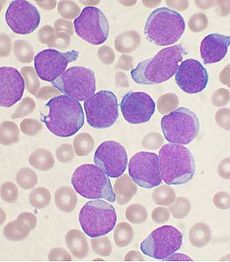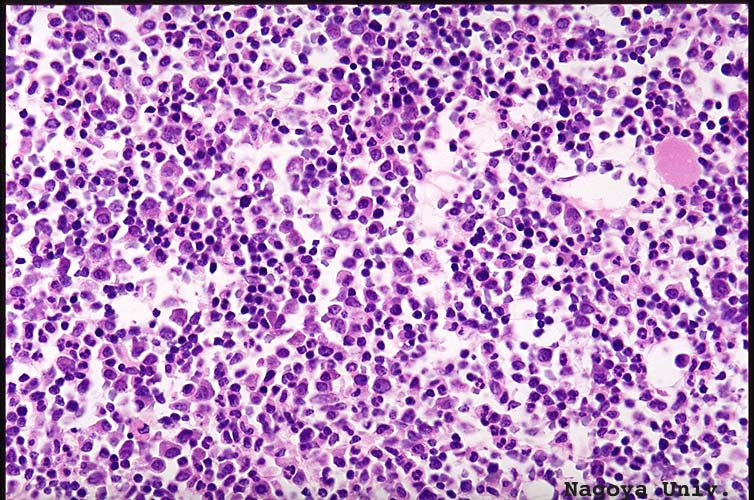Page Contents
WHAT IS IT?
Acute lymphoblastic leukemia/lymphoma (ALL) is a hematological neoplastic disorder that involves the overproduction of immature B or T cells (lymphoblasts). As the name suggests, this is a disease of acute onset (days to weeks) of symptoms. Many different genetic abnormalities (including the Philadelphia chromosome seen in CML) can cause this disease by promoting an increased proliferation of lymphoblasts.
Subclassificaiton: characterizing whether the malignant cells are B or T cells helps further classify the type of ALL. Most ALLs are precursor B-cell cancers.
- Pre-B-cell: most manifest in childhood, and manifest with extensive bone marrow and blood involvement.
- Pre-T-cell: occurs in adolescents, and presents with a mediastinal mass
WHY IS IT A PROBLEM?
The overproduction of B-cells within the bone marrow eventually leads to bone marrow failure, and can compromise the production of other cell types including: red blood cells, neutrophils, and platelets. This leads to anemia, frequent infection, and thrombocytopenia.
WHAT MAKES US SUSPECT IT?
Risk factors: children, hispanic, radiation exposure
Common chief complaints: these relate to the pathophysiology of the disease (bone marrow failure) in an intuitive way.
- Generalized weakness/fatigue (anemia)
- Frequent infections (neutropenia)
- Frequent episodes of bleeding (thrombocytopenia)
Other symptoms/findings: are a result of the voluminous spread of malignant pre-B/pre-T cells.
- Enlarged lymph nodes
- Hepatomegaly
- Splenomegaly
- Bone/joint pain (overproduction of cells in marrow)
- Altered mental status (CNS involvement/metastasis)
- Testicular enlargement (spread to the testicles).
HOW DO WE CONFIRM A DIAGNOSIS?
Complete blood count (CBC): these are the likely findings in a patient with ALL:
- Increased white blood cell count (WBC) above 100,000cells/mm^3 or decreased WBC (below 10,000 cells/mm^3) with increased lymphocytes specifically *the higher this white count, the worse the prognosis
- Low hemoglobin (can be normocytic, but also macrocytic if folate is also low)
- Low platelets (thrombocytopenia)
Peripheral blood smear: increased presence of malignant pre-B/pre-T cells (which can’t be distinguished from each other on the smear). These are lymphoblast cells that have condense chromatin, minimal cytoplasm, and do not contain granules.

Bone marrow biopsy: this is diagnostic if more than 20% blasts are seen. It is even possible that most all normal marrow cells are replaced by malignant cells.

Immunohistochemical testing: can stain for the following proteins to aid in the diagnosis.
- Terminal deoxynucleotidyl transferase (TdT): this is a DNA polymerase that is a marker for pre-B cells or pre-T cells (thought to be a sign of immaturity). ABSENT IN MYELOBLASTS AND MATURE LYMPHOCYTES
- Common acute lymphoblastic leukemia antigen (CALLA): also known as CD10, this marks a population of cells that are pre-B cells.
*If TdT positive and not CALLA/CD10 positive then likely a pre-T cell cancer
Cytogenetics: this can help detect the presence of translocations. The 12:21 chromosomal translocation is a common one that confers a relatively good prognosis. The 9:22 (Philadelphia + ALL) has a poor prognosis
HOW DO WE TREAT IT?
Aggressive chemotherapy is used as the mainstay of treatment, with 4 major components:
- Induction: multi drug regimen (ex: vincristine, L-asparaginase, and corticosteroids, with or without anthracyclines) used to induce remission
- Consolidation: new drug regimen that begins after induction.
- Central nervous system (CNS)-directed therapy: exactly as it sounds, this is used to prevent spread to the CNS (starts at induction for those who are at risk for CNS involvement)
- Maintenance: yet another drug regiment that follows consolidation.
Hematopoietic stem cell transplant (HSCT) is a possible treatment but is reserved for patients who fail induction or at very high risk for recurrence.
HOW WELL DO THE PATIENTS DO?
With aggressive chemotherapy, more than 90% of children achieve complete remission, and at least ~60% are cured.
WAS THERE A WAY TO PREVENT IT?
No clear prevention means, however given the likelihood of radiation as a risk factor, limiting radiation to young infants is always preferred.
WHAT ELSE ARE WE WORRIED ABOUT?
Down syndrome is a condition ALL is associated with
OTHER HY FACTS?
Most cases of ALL in children under the age of 15
ARCHIVE OF STANDARDIZED EXAM QUESTIONS
This archive compiles standardized exam questions that relate to this topic.
Page Updated: 01.11.2016